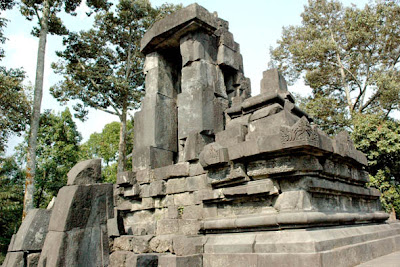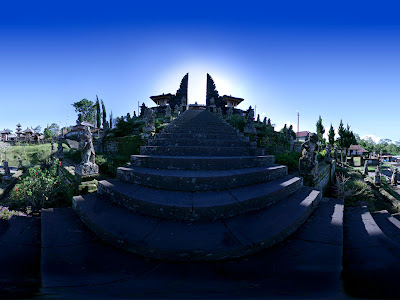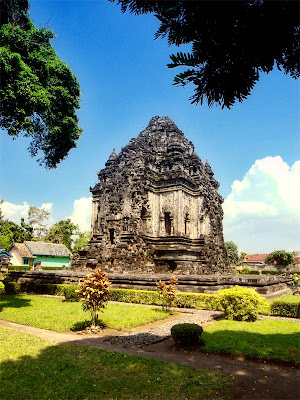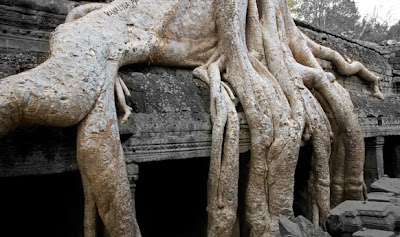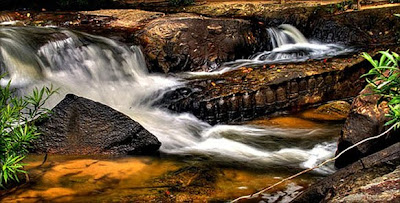Home » Posts filed under Temple
Luhur Temple Uluwatu is one of the temples in Bali with a very beautiful location. The main attraction for tourists from the temple is a spectacular panorama. Located in the northwest, the temple is perched on the edge like a very high rock cliffs and steep, with views of the sea under a blue net and hit the waves that produce white bubbles are very beautiful.
Uluwatu Temple is a temple rich in historic and magical value. This temple is so incredible, standing on a cliff with a height of about 30 meters in the middle of lacing the Indian Ocean. Uluwatu is known as a great place to surf and spend time at the beach.
 |
| Pura Luhur Uluwatu |
Pura Besakih, Bali's largest temple, located in the eastern part of Bali precisely in Karangasem regency. This temple stands firmly at the foot of Mount Agung and every ceremony performed there is always populated by both Hindus from all over Indonesia.
Besakih name comes from the word "Basuki", taken from the word "Wasuki" which means security in Sansekertanya. Whereas, in mythology Samudramanthana, the name "Besuki" actually refers to the "Dragon Besukian", who live in Gunung Agung, Bali's main volcano.
Pura Besakih Complex consists of 18 Pura Pura and 1 Utama. Pura Besakih is the hub of the Temple is in Bali. Among all pretend that includes the complex Pura Besakih, Pura Agung is a shrine for the Promotion of the largest, most buildings pelinggihnya, most of upakaranya and is the center and all that is in the Besakih temple. In general for the Promotion of Pura there are 3 main sculpture Tri Murti Brahma, Vishnu and Shiva who typify God the Creator, God the Lord and God smelters.
This large temple complex has been considered a sacred place since ancient times. Based on the records of ancient inscriptions in 1007 AD. It is known that since the 15th century, regarded as the central Besakih Hindu temple in Bali.
Besakih Temple, also known as Penataran General is the main place of worship of Hindus in Bali. Is a complex consisting of 22 temples in the mountains parallel.
During the full moon, Balinese people and pilgrims flocked to the shrine. During the festival Odalan, pretend to be decorated beautifully. Odalan celebrated each day to 210.
Cangkuang Temple is a temple of Hindu cultural heritage in the VIII century located in West Java. The temple in which there is a statue of the god Shiva's whereabouts unknown in 1966 on the basis of written Vorderman, in Minute book Bataviaasch Genootschap in 1893.
Cangkuang area is a tourist attraction in the form of lakes, Pulo village with home cultures, and a temple on an island in the middle of the lake. The island is actually like a peninsula that juts eastward into the middle of the lake.
Cangkuang Temple is located on an island of small elongated, stretching east-west direction with a size of 16.5 hectares. This small island located in the middle of a lake known as Situ Cangkuang. In addition there are islands of the lake is long, there are also two other islands are located in the south and southeast of the island long. Both these islands are smaller and slightly rounded shape. All around this small island is a watery swamp land.
Feelings of awe, but the heart feels peaceful and calm when passing through the lake known as Situ Cangkuang. This is due in this unusual journey, you can enjoy the natural beauty that given the existence of a unique lake and surrounded by several mountains are mountains Haruman, Kaledong mountain, mountain Mandalawangi and mountain Mandalawangi Guntur.
One more feature of this area there is Pulo village with traditional houses. The house rules are simple but extraordinary. In the village there are 7 homes allocated to the child "grandparent Dalem" consisting of 6 women and 1 man. 7th house is 6 houses that lined face three left and 3 right hand and a mosque (house boys). The number of homes should not be added to existing homes and 6 should not comprise more than six heads of households so that when someone got married, the child must come out. As per rules of the houses are owned by the women and not men. Other villages such rules should not be hitting the gong and should not be raising cattle quadrupeds. If you want to know more, please do not hesitate to visit this special place.
Name Muara Takus may not yet as popular as his brother Borobudur temple, Prambanan temple. But the nuances of history offered no less interesting.
Muara Takus temple complex is the only heritage that shaped temple in Riau. Temple nuanced Buddhistis this was proof that Buddhism once flourished in this region. Nevertheless, archaeological experts have not been able to determine exactly when this temple was founded.
The temple is located in the Village Muara Takus, District Tigabelas Koto Kampar, Kampar District, Riau Province.
 |
| Temple Muara Takus |
Muara Takus Temple is a Buddhist temple, visible from the stupa, which is a symbol of the Buddha Gautama. There are opinions that say that this temple is a mixture of forms of Buddha and Shiva temple. The opinion is based on the shape of Mahligai Temple. The architecture of this temple also has similarities with the architecture of temples in Myanmar. Muara Takus Temple is a complex consisting of several buildings.
The site is supposedly the oldest in the world the rest of the triumph of the kingdom of Srivijaya. When the opportunity to visit the country this Malay, it is not complete if not stopping there. In addition to enjoying its beauty may also to uncover the veil of the great civilizations of the past carved and engraved there.
Temple Muara Takus - Riau
The temple is located in the village Bahal, Alternating Padang District, South Tapanuli District, North Sumatra. This temple is a temple complex (in local terms is called Biaro) the largest in North Sumatra province.
Bahal Temple is only part of the temples Padanglawas meaning temples located in the broad field that includes, among them: Pulo Temple, Temple Barumun, Singkilon Temple, Sipamutung Temple, Aloban Temple, Rondaman Dolok Temple, Bara Temple, Magaledang Temple, Nagaseribu and Sitopayan Temple. Chances are, rice fields and villages around the temples was once a vast desert. Of the many temples Candi Bahal Padanglawas just completed renovated, Temple Pulo Sipamutung and temples are in the process of renovation, while others are still in the form of temple ruins.
 |
| Temple Bahal - North Sumatra |
It is not known whether Candi Bahal is a Hindu temple or Buddhist temple. Judging from the roof of the temple "Bahal I" which is similar to the shape of the roof at Temple Mahligai Barelang Bahal Temple is a temple believed to Buddha. However, seeing the stone statues found at the site, such as the makara head statues, Ganesha statues, giant, etc.., Estimated temple is a Hindu temple or Tantric Buddhism. Bahal temple function in the past is also not known with certainty, although residents in the vicinity called "Biaro" which means monastery.
The temple became the first visit is the temple of Prambanan. Geographically, the Prambanan temple is located on the border between the districts of Sleman and Klaten, precisely in the hamlet of Karangasem, Bokoharjo Village, Prambanan District, Sleman District, Yogyakarta Special Region. Prambanan temple is divided into 3 pages concentric (centered), associated with the gate located on each side. While surrounded by a fence outside the page size of 390 x 390 m, the central courtyard surrounded by a fence wall measuring 220 x 220 m.
In the center of the page there are 16 buildings of the temple. which became the parent of the other temples. For safety and convenience, visitors will be accompanied by a friendly staff and loyal.
The architectural, building Kalasan have a distinctive style, which is wide and protrudes out. In each of the viewer, there are several chambers of the four cardinal directions (west, east, south and north). In addition to adorning the four chambers of the outer side, there are also booths containing a throne made? of stone and has a pedestal, while the rest are on either side that there is a lion statue which stands on an elephant.
Sambisari discovered in 1966, by a farmer who was hoeing Karyowinangun property, then, the spade hit on the stone ukirang which is the cornerstone of the temple ruins.
If entered into the temple area then you can see a Lingga and Yoni. Lingga is itself a manifestation of Shiva, while Yoni is a manifestation of Sakti (wife) of Shiva. As for the exterior, you'll find some of the Hindu pantheon, namely Durga Mahisasuramardhini (north), Ganesh (east), Agastya (south), Mahakala and Nandiswara as a doorman. From these signs it can be seen that the religious background Sambisari is "Çiwaistis."
Of the three temples that we visit it can be seen that these temples is the pattern of Hindu-Buddhist-influenced by the socio-cultural context, especially in the Indian classical.
Ancient heritage has many benefits, one can know what faith is embraced by the public long ago, and hopefully useful.
Temple complex surrounding the small town of Siem Reap is now no longer hidden. Now, all people have friends who've never climbed the towers of Angkor Wat. De facto, become the main temple of Angkor Wat in Cambodia.
Towers visible in the middle of the Cambodian flag and the national beer labels, Angkor Beer. But there are hundreds of temples in Siem Reap, either already damaged or that are still maintained. Unless you are visiting for several weeks, no way you can see all the temples. Here are the three most favorite temple that I recommend to you visit. I did not include Angkor Wat for two reasons: 1) It's not my favorite, and 2) That a large temple complex with a complex history and significant, so you can not miss it.
Bayon
Bayon Temple is known as the Front (Temple of Faces). When you visit it, will very easily find out the reason behind the name - while climbing the steep stone steps toward the holy temple, hundreds of faces will look in your direction.
Although they seem to smile, I feel there is a little dangerous weather, as if waiting for makers of stone statues were to walk back from the forest. Although many temples were destroyed, it is still easy to imagine the incredible sight when the complex was first built - the house really worth the earth for the gods.
Banteay Srei
During the first ten minutes at Banteay Srei, you will continue to stare amazed intricate carvings on every inch the rock, wondering what exactly is it made of wood. Even with today's technology, almost unbelievable that the intricate patterns and details on the statue could be made in stone. This temple, unlike the others, made of red sandstone that is more easily carved and give reddish gold hue on the complex.
Most of the entrance and the tower of the temple are still preserved and intact condition (be careful of your head because the doors are quite short!), but some sculpture at the side of the staircase is actually a replica. Original statue is stolen or has been stored in museums. If there is an art contest, Banteay Srei will win easily because of the originality and attention to detail.
Ta Prohm
If you ever watch Tomb Raider, some movie scenes that take place in the temple of Ta Prohm, do not need special effects to give the impression of sinister and surreal. Temple complex is located in a state of near-collapse. For centuries, rooted tree on the temple walls. The conservationists temple let the trees because, so it has its roots, strengthen the construction of the temple tree. If omitted, then the remaining temple will collapse.
Siem Reap, the former army headquarters city of the country controlled by bloodthirsty ruler of the Khmer Rouge, now developed wonderfully into an international tourist destination. Even Siem Reap obtain status as a UNESCO World Heritage Site and one of the Seven New Wonders of the World.
Though only 20 years ago this area off limits to tourists, local residents were terrorized and dominated by the fear of one of the most brutal regimes in the world.
Amazing Angkor Wat
Angkor Wat temple is the largest, most well maintained, has the most intricate designs and most admirable in Indochina, a jewel in the crown of a vast kingdom of Angkor.
The temple is a source of national pride and international recognition, encased reliefs of the Hindu epic Ramayana. Like most Hindu temples in Asia, Angkor Wat looks more beautiful at dawn or before sunset, when the sky filled with colors that highlight the five towers.
Nine Figures
For the first Asian to know you have to understand the trust on the continent, and this is seen clearly in the environment of Angkor Thom, a temple that was glued to the number nine. Saying "nine" is similar to the word "development", and almost everything on the temple can be compared to this figure - 54 towers carved, 216 faces in the tower, 54 gods to the left of the entrance, and 54 demons on his right - all these figures can be added up to a point 9.
Other Temples
Another Angkor temple is also famous Ta Prohm, roots of trees surrounded by hundreds of years old. The root of the tree makes Ta Prohm interesting photo so that the objects of successful reaching tourists.
Bayon is also known as "Temple's face", and when you are there, easy to understand why the name was girded. Once you climb the stone steps to the shrine inside the temple, when looking up will appear hundreds of stone carving faces looking at you. There is also Banteay Srei, a temple filled with amazing carvings fulfill every inch of stone there. Even with current technology, almost impossible to make the patterns as precisely and as complex as it is in stone sculpture.
River Revitalization
About 50 km northeast of Siem Reap, there is the Thousand Linga River flows into the river in Siem Reap are essentially filled with carvings Linga - the symbol of phallus which is very common in Cambodia. Estimates, carvings were made between 1100-1300 to symbolize fertility. Now the river is a perfect place to enjoy the tropical beauty of Siem Reap.
Tonle Sap
Siem Reap not only has a world famous archaeological sites, but also has one of the largest and most colorful lakes in Southeast Asia.
UNESCO has set the Tonle Sap as a biosphere reserve, nature reserve is a habitat for wildlife water several rare birds and became the only river in the world that the water flow changed two times a year.
Contemporary Art
Fine art in Siem Reap is in progress, you can find everything from cheap souvenirs to expensive art work. Some noteworthy places art lovers, among others: the McDermott Gallery, where world-class photography will Angkor and the surrounding area display; The Red Gallery, which has the most diverse collection of contemporary art from Cambodia, and The Asia Craft Center, where various kinds of traditional crafts in Cambodia and Southeast Asia.
Colonial Architecture
Siem Reap has colonial era buildings of the French heritage that is now converted properly. Located at the intersection and roundabout calm, the buildings became hotels, restaurants and the best gallery in Siem Reap, such as the Raffles Grand Hotel D'Angkor, the most luxurious hotels in the city was founded in 1932. The hotel was once visited by many VIP guests, including King Norodom Sihanouk, Charlie Chaplin, the Sultan of Johor and even Jacqueline Kennedy.

